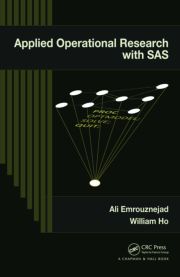Abreu Urbano GD, S Lopes Paulo, S Baptista Antonio J. M. Dos, A Torres Robledo De and N Santos Heleno (2004). “Evaluation of Technology Introduction into a Beef Cattle Production.” in Emrouznejad A and V Podinovski (eds.) Proceedings of DEA2004, Birmingham, UK: 178.
Adam JEE (1994). “Alternative Quality Improvement Practices and Organization Performance.” J Operations Management 12(1): 27-44.
Adam JEE (1994). “Alternative Quality Improvement Practices and Organization Performance.” J Operations Management 12(1): 27-44.
Adenso-Diaz B and B Lev (2002). “Reviews the Book “Introduction to the Theory and Application of Data Envelopment Analysis: A Foundation Text with Integrated Software,” By Emmanuel Thanassoulis.” Interfaces 32(5): 102-104.
Adenso-Diaz B and B Lev (2002). “Reviews the Book “Introduction to the Theory and Application of Data Envelopment Analysis: A Foundation Text with Integrated Software,” By Emmanuel Thanassoulis.” Interfaces 32(5): 102-104.
Adler N, L Friedman and Z Sinuany-Stern (2002). “Review of Ranking Methods in the Data Envelopment Analysis Context.” EJOR 140(2): 249-265.
Adler N, L Friedman and Z Sinuany-Stern (2002). “Review of Ranking Methods in the Data Envelopment Analysis Context.” EJOR 140(2): 249-265.
DEAzone’s blog
This is a bolg of the DEAzone.com. To post to this blog you need to register and login.
BCC
Introduced by Banker, Chames and Cooper (1984), this model measures technical efficiency as the convexity constraint ensures that the composite unit is of similar scale size as the unit being measured. The resulting efficiency is always at least equal to the one given by the CCR model, and those DMUs with the lowest input or highest output levels are rated efficient. Unlike the CCR model, the BCC model allows for variable returns to scale.
Multiplier form
Associated with each DEA model type (eg CCR, BCC) is both a primal and dual formulation. To avoid confusion over which formulation is primal and which dual, the multiplier form is always understood to refer to the formulation involving virtual multipliers (Ali and Seiford 1993). [Ali A and Seiford L (1993), ‘The mathematical programming approach to efficiency analysis’, in: Fried H, Knox C A K and Schmidt S (editors), The measurement of productive efficiency: techniques and applications, Oxford University Press.
Ratio models
The CCR and BCC models both define efficiency as a ratio of weighted outputs over weighted inputs, hence they are often known as ratio models.
Visualisation
The process of developing a set of visual techniques such as graphs and charts through which the DEA results can be better understood.
Nondiscretionary factor
Same as exogenously fixed factor.















